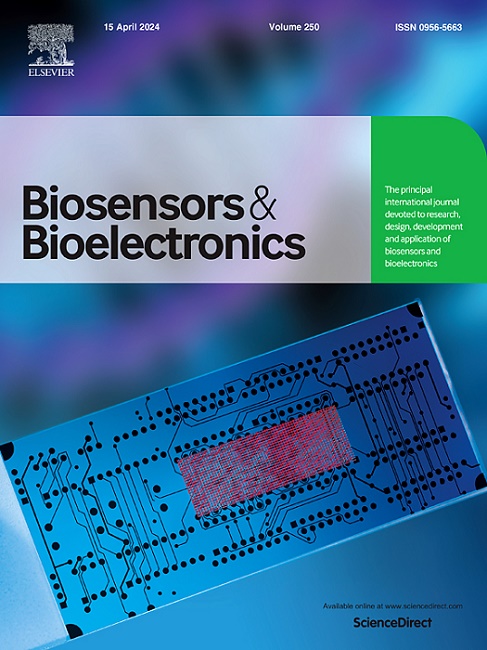ZnO-Nafion assisted optical fiber dual-SPR biosensor for simultaneous detection of urea and uric acid concentrations
IF 10.5
1区 生物学
Q1 BIOPHYSICS
引用次数: 0
Abstract
A novel dual-parameter optical fiber biosensor based on surface plasmon resonance (SPR) for simultaneous measurement of urea and uric acid concentrations is proposed in this paper. Based on the principle of positive and negative electric combination, ZnO nanoparticles is selected as the matrix for immobilizing urease and uricase with selective recognition ability, which can also be used as a sensitizing material to increase the refractive index detection sensitivity of SPR by 22%. Then, Nafion ion exchange membrane was introduced to wrap the urea sensing area to avoid crosstalk caused by the overlap of adjacent sensing areas. The difference in the number of enzymes loaded on ZnO nanoparticles was used to meet the refractive index gap for forming dual SPR detection channels. Experiments indicate that the sensitivity of urea detection is 1.6 nm/mM in the range of 1–9 mM urea concentration. The detection sensitivity of uric acid is 36 nm/mM in the concentration range of 50–500 μM. The detection ability of the sensor to actual biological samples was verified by serum samples, which proved that the sensor has practical application potential and reliable selectivity. It can provide a new idea for the research and development of multi-parameter optical fiber biosensors.
ZnO-Nafion辅助光纤双spr生物传感器用于同时检测尿素和尿酸浓度。
提出了一种基于表面等离子体共振(SPR)的双参数光纤生物传感器,用于同时测量尿素和尿酸浓度。基于正负电结合原理,选择ZnO纳米颗粒作为固定脲酶和具有选择性识别能力的脲酶的基质,也可作为增敏材料,使SPR的折射率检测灵敏度提高22%。然后,引入Nafion离子交换膜包裹尿素传感区域,以避免相邻传感区域重叠引起的串扰。氧化锌纳米粒子上负载的酶数量的差异被用来满足折射率间隙,形成双SPR检测通道。实验表明,在1 ~ 9 mM尿素浓度范围内,尿素检测的灵敏度为1.6 nm/mM。尿酸在50 ~ 500 μM的浓度范围内,检测灵敏度为36 nm/mM。通过血清样品验证了该传感器对实际生物样品的检测能力,证明了该传感器具有实际应用潜力和可靠的选择性。这为多参数光纤生物传感器的研究和开发提供了新的思路。
本文章由计算机程序翻译,如有差异,请以英文原文为准。
求助全文
约1分钟内获得全文
求助全文
来源期刊

Biosensors and Bioelectronics
工程技术-电化学
CiteScore
20.80
自引率
7.10%
发文量
1006
审稿时长
29 days
期刊介绍:
Biosensors & Bioelectronics, along with its open access companion journal Biosensors & Bioelectronics: X, is the leading international publication in the field of biosensors and bioelectronics. It covers research, design, development, and application of biosensors, which are analytical devices incorporating biological materials with physicochemical transducers. These devices, including sensors, DNA chips, electronic noses, and lab-on-a-chip, produce digital signals proportional to specific analytes. Examples include immunosensors and enzyme-based biosensors, applied in various fields such as medicine, environmental monitoring, and food industry. The journal also focuses on molecular and supramolecular structures for enhancing device performance.
 求助内容:
求助内容: 应助结果提醒方式:
应助结果提醒方式:


